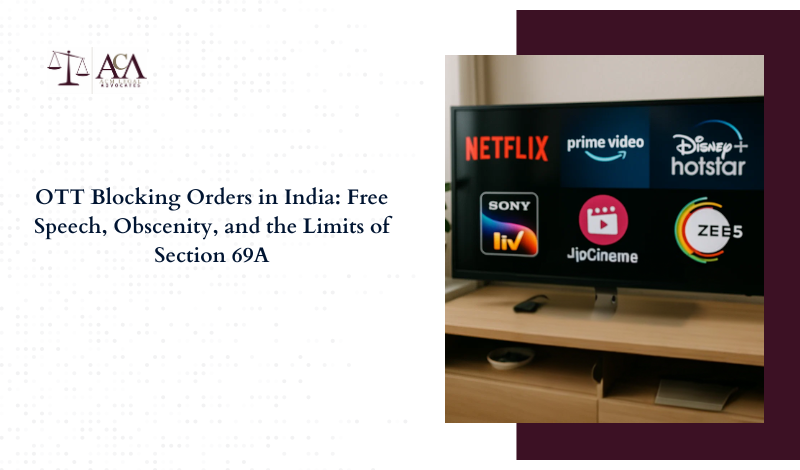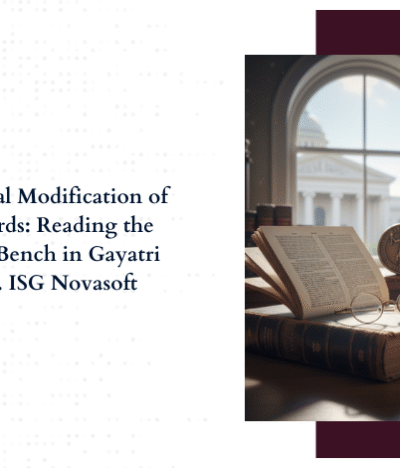The Ministry of Information and Broadcasting recently ordered the blocking of more than two dozen Over-the-Top (OTT) platforms, citing the broadcast of “obscene” and “vulgar” content. The move, while politically popular in some quarters, raises pressing constitutional questions. India’s blocking powers flow from Section 69A of the Information Technology Act, 2000, read with the Blocking Rules of 2009. These powers are not unbounded. They must be exercised within the grounds set out under Article 19(2) of the Constitution—such as decency, morality, and public order—and are subject to the doctrine of proportionality.
The growing number of OTT blocking Section 69A challenge petitions before High Courts reflects a clash between digital regulation and constitutional freedoms. Are sweeping takedowns for “obscenity” legally sustainable? Or do they risk being disproportionate and unreasoned, thereby inviting judicial intervention?
Section 69A Framework and OTT Regulation
Section 69A of the Information Technology Act, 2000 is the central legal tool through which the Government can block access to online content. The provision, read with the Information Technology (Procedure and Safeguards for Blocking for Access of Information by Public) Rules, 2009, authorises the Ministry of Information and Broadcasting or the Ministry of Electronics and IT to issue blocking directions to intermediaries, including OTT platforms. The stated grounds must fall within the categories permitted under Article 19(2) of the Constitution—sovereignty, integrity, public order, decency or morality, among others.
The Supreme Court in Shreya Singhal v. Union of India[1] upheld Section 69A but stressed that its safeguards—notice, hearing, and a reasoned order—are not optional. Every blocking direction must be specific, proportional, and justified in writing. Yet, in practice, most orders are kept confidential, leaving platforms with limited ability to contest them and the public with little clarity about why a site or app has disappeared.
This tension is sharper in the case of recent OTT blocking orders for obscenity. Unlike hate speech or incitement, “obscenity” is not expressly listed in Section 69A. It must be linked back to “decency” or “morality” under Article 19(2). When entire platforms are blocked rather than specific shows, the question arises whether the State has crossed the line from regulation into blanket censorship. It is precisely this concern that fuels ongoing OTT blocking Section 69A challenge petitions before Indian courts.
Proportionality and Platform-Wide Blocking
Indian constitutional jurisprudence now demands that any restriction on free speech pass the proportionality test. This requires the State to demonstrate (i) a legitimate aim, (ii) a rational connection between the restriction and that aim, (iii) necessity—meaning no less restrictive alternative exists, and (iv) a balance between the restriction and the right itself.
Applied to OTTs, this means that blocking an entire platform because of objectionable content on a few shows is rarely justifiable. The principle of proportionality would instead require the government to target the specific episodes, films, or clips that allegedly cross the line of “decency” or “morality.” Shutting down a whole platform punishes lawful content along with the unlawful, creating a form of collateral censorship.
Courts in India have already hinted at this approach. In Shreya Singhal, the Supreme Court stressed that blocking powers must be narrowly tailored and supported by reasoned orders. High Courts, too, have pressed for disclosure of the grounds of blocking so that affected parties can seek judicial review. A blanket shutdown without a detailed justification risks failing this test.
The wave of OTT blocking Section 69A challenge petitions is therefore as much about judicial enforcement of proportionality as it is about free speech. The State cannot merely assert “obscenity” and expect deference; it must show why less intrusive measures, such as content-specific blocking or age-gating mechanisms, would not suffice.
Reasoned Orders and Judicial Review
A central safeguard in the Section 69A regime is the requirement that every blocking order be accompanied by reasons, recorded in writing. This is not a technicality—it is a constitutional necessity. Without written reasons, neither the affected OTT platform nor a court can assess whether the State has stayed within the boundaries of Article 19(2).
The Supreme Court in Shreya Singhal underscored that secrecy and unreasoned orders would render Section 69A unconstitutional in practice. Yet, many blocking orders remain unpublished, and when platforms approach courts, they often discover that they cannot access the government’s reasoning. This undermines the very right to challenge the order, leaving judicial review hollow.
In the specific context of “obscenity,” the need for reasoned orders is even more acute. Indian obscenity law has evolved since Ranjit Udeshi through Aveek Sarkar, moving toward a community-standards test that asks whether the dominant theme, taken as a whole, appeals to prurient interests or crosses the line of decency. A bare assertion that “content is obscene” does not meet this threshold. Orders must articulate why particular shows or scenes offend the standards of decency or morality, and how platform-wide blocking is the least restrictive way to address it.
Constitutional Limits under Article 19(2)
Article 19(1)(a) guarantees freedom of speech and expression, but Article 19(2) permits “reasonable restrictions” on limited grounds: sovereignty and integrity of India, security of the State, friendly relations with foreign States, public order, decency or morality, contempt of court, defamation, and incitement to an offence. Importantly, “obscenity” is not an independent ground. It survives only insofar as it falls under “decency” or “morality.”
This distinction matters in the context of OTT blocking orders. If the government cites “obscenity” without explaining how it undermines decency or morality, the order may lack constitutional footing. Courts have made clear that grounds under Article 19(2) are exhaustive, not open-ended. Expanding them through executive fiat risks judicial pushback.
Further, the restriction must always be reasonable—a term courts interpret through proportionality, narrow tailoring, and non-arbitrariness. A sweeping ban on an OTT platform because of a handful of controversial shows will struggle to survive this scrutiny. By contrast, a targeted order blocking specific episodes, accompanied by reasons, could fall within constitutional bounds.
As more OTT blocking Section 69A challenge petitions reach the judiciary, the line between legitimate regulation and unconstitutional censorship will be tested. Courts will have to balance competing values: protecting citizens from genuinely harmful content while preventing executive overreach into cultural and creative expression.
Conclusion
The spate of OTT blocking orders for “obscenity” highlights a recurring tension in Indian digital law: the State’s desire to regulate content colliding with the constitutional guardrails of Article 19(2). Section 69A gives the government strong powers, but those powers are not unfettered. They must be exercised with reasoned orders, transparent procedures, and in a manner that respects the doctrine of proportionality.
India’s courts, for their part, are likely to play a decisive role in setting the limits. If judicial review insists on transparency and proportionality, blocking powers can be reconciled with free expression. If not, we risk sliding into an opaque censorship regime that undermines both constitutional freedoms and the credibility of digital governance.
[1]Shreya Singhal vs U.O.I on 24 March, 2015.






